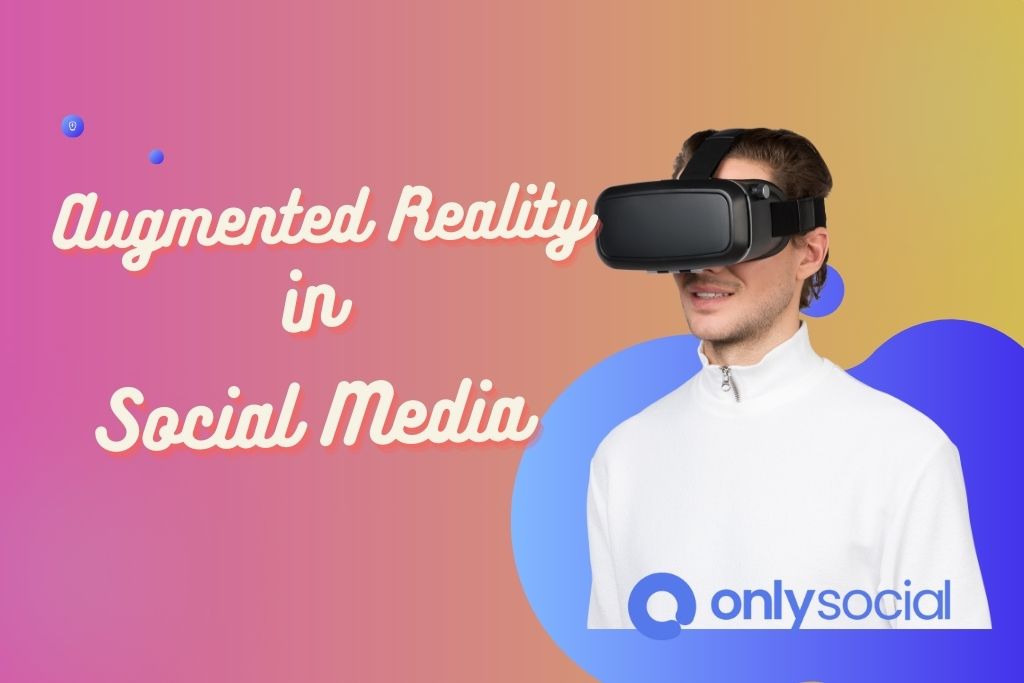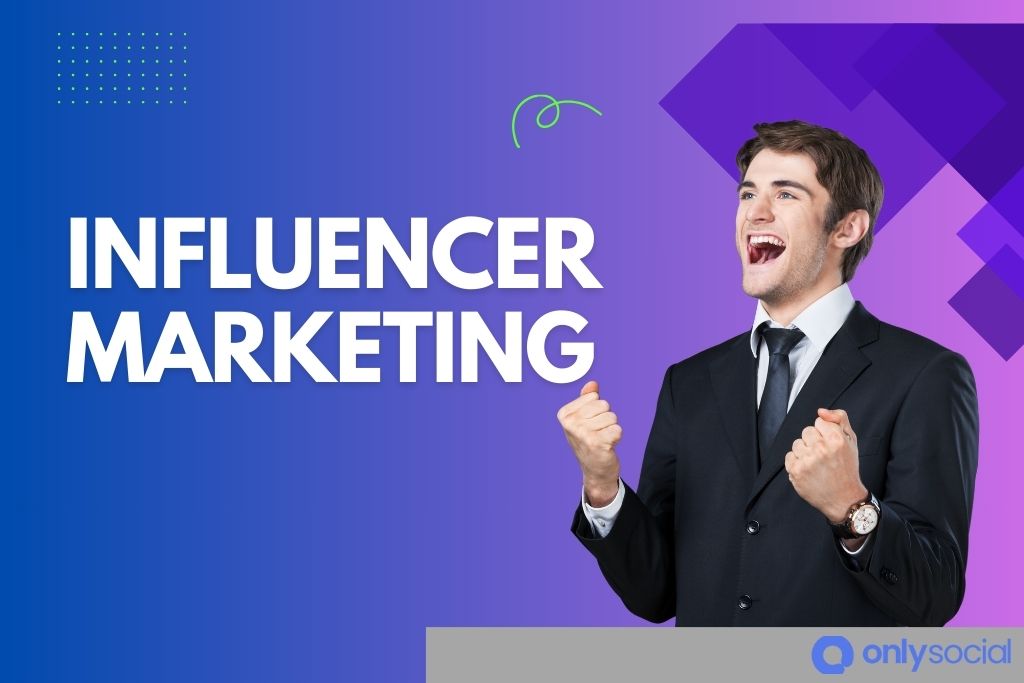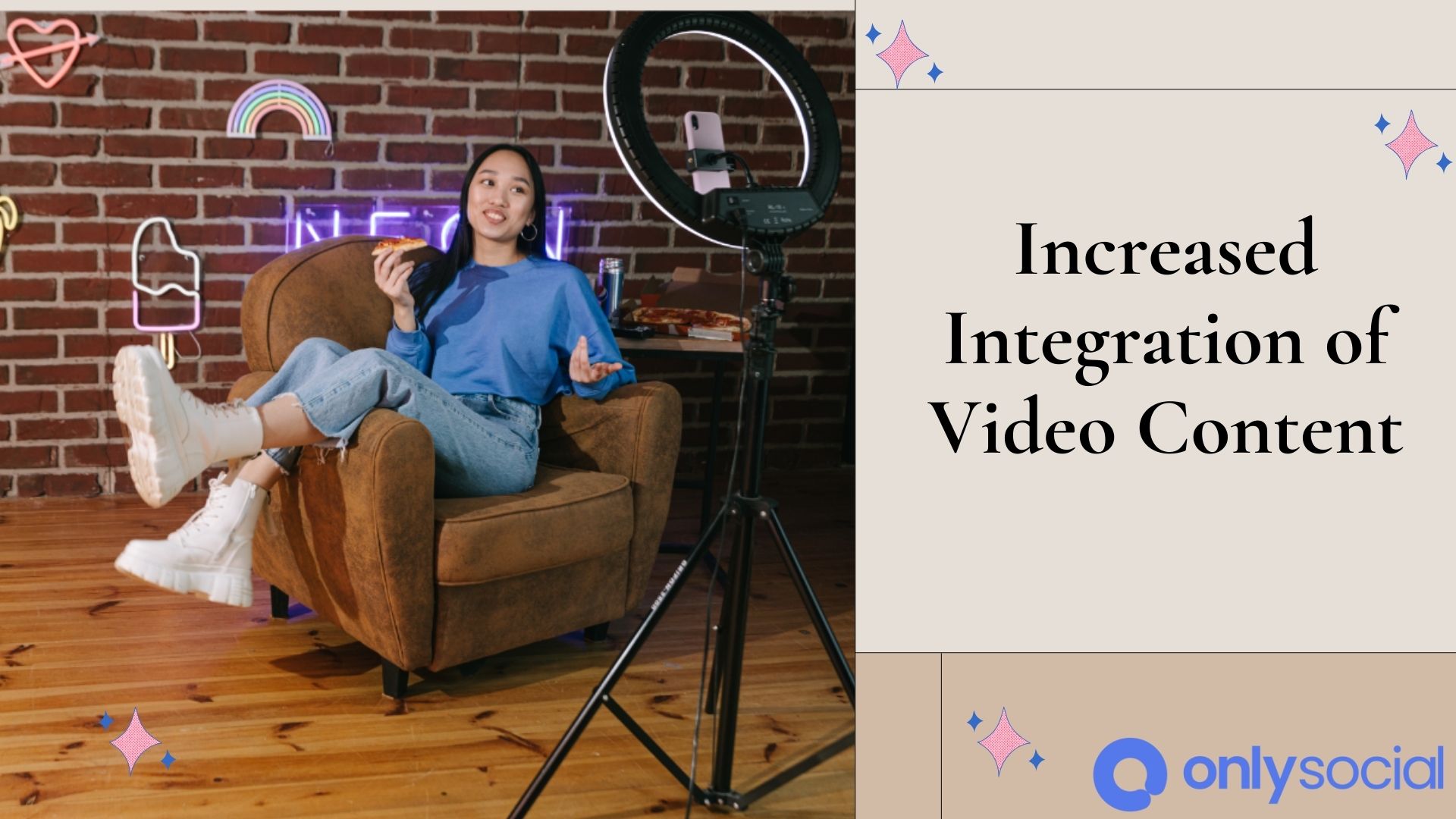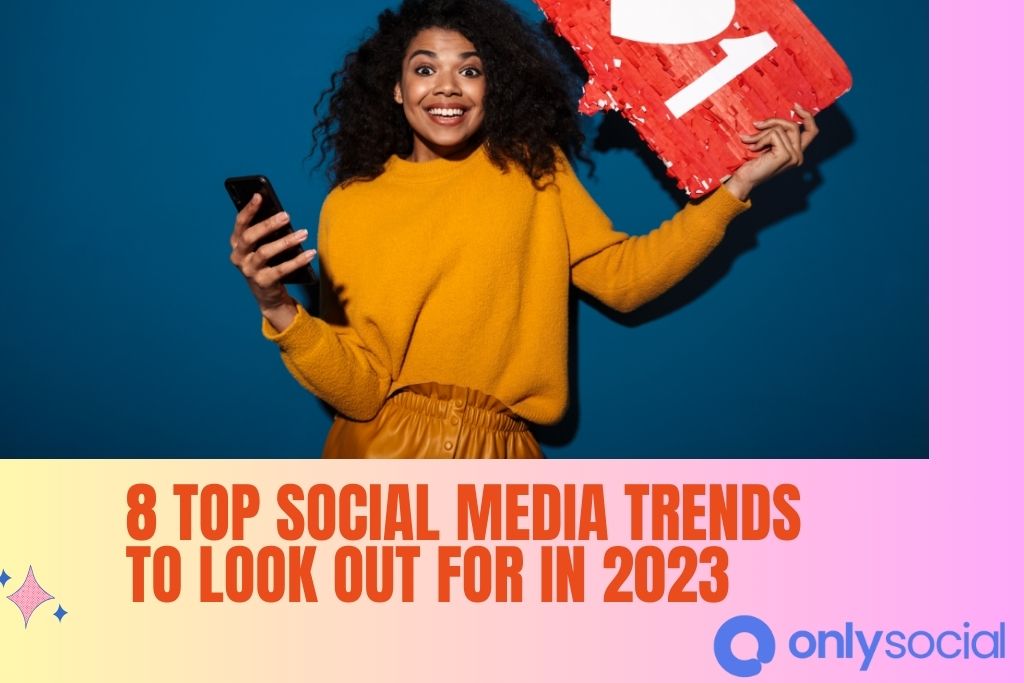The world of social media is constantly evolving, bringing challenges and opportunities for individuals and businesses like yours. As we look ahead to 2023, we can expect several trends that will shape the social media landscape. This article overviews eight exciting trends dominating social media in the coming year. By exploring data-driven insights and strategic analysis, we’ll equip you with the knowledge to stay ahead in this ever-changing digital environment.
Table of Contents
- 1 1. Tailored Content Experiences
- 2 2. Authentic Influencer Marketing
- 3 3. Augmented Reality (AR) Experiences
- 4 4. Social Commerce Boom
- 5 5. Micro-communities and Niche Networks
- 6 6. Video Dominance
- 7 7. Social Listening and Conversation Analysis
- 8 8. Privacy and Data Security
- 9 Rise of Augmented Reality (AR) in Social Media
- 10 Emphasis on User-Generated Content (UGC)
- 11 Growth of Influencer Marketing Strategies
- 12 Increased Integration of Video Content
- 13 Expansion of Ephemeral Content and Stories
- 14 The Power of Social Commerce
- 15 Personalization and Customization in Social Media
- 16 Emerging Social Media Platforms and Trends
- 17 BONUS
- 18 Frequently Asked Questions
- 18.1 How Does Augmented Reality Enhance the User Experience in Social Media?
- 18.2 What Are Some Examples of Successful User-Generated Content Campaigns in Social Media?
- 18.3 How Can Businesses Effectively Utilize Influencer Marketing Strategies on Social Media?
- 18.4 What Are the Benefits of Using Video Content in Social Media Marketing?
- 18.5 How Do Ephemeral Content and Stories Contribute to Brand Storytelling on Social Media?
1. Tailored Content Experiences
In 2023, social media will become even more personalized, with platforms offering tailored content experiences based on individual preferences and interests. Imagine a feed that perfectly aligns with your passions, delivering content that truly resonates with you. This trend will enable you to engage with content that matters most, enhancing your overall social media experience.
2. Authentic Influencer Marketing
Authenticity will be the name of the game in influencer marketing. As consumers become savvier, they crave genuine connections and real experiences. In 2023, brands will partner with influencers who align with their values and genuinely believe in their products or services. This shift towards authenticity will foster stronger relationships between influencers, brands, and their target audiences.
3. Augmented Reality (AR) Experiences
Get ready for a more immersive social media experience with augmented reality (AR) technology. 2023 AR will take center stage, allowing users to interact with virtual elements in their real-world environment. AR will revolutionize how we engage with brands and products on social media, from trying on virtual outfits to exploring virtual showrooms.
4. Social Commerce Boom
In 2023, social media platforms will become the go-to destination for shopping and transactions. Social commerce is set to boom, with features like in-app purchases, shoppable posts, and seamless checkout experiences becoming the norm. This trend will make it easier for businesses to connect with customers and drive sales directly through social media.
5. Micro-communities and Niche Networks
Social media will become more niche-focused in 2023 as micro-communities and specialized networks gain popularity. These platforms will cater to specific interests and hobbies, fostering deeper connections and meaningful conversations. By joining these niche networks, you’ll have the opportunity to engage with like-minded individuals who share your passions.
6. Video Dominance
Video content will continue to dominate social media in 2023. Short-form videos, live streams, and interactive video formats will captivate audiences, offering a more engaging and immersive experience. Businesses and content creators should embrace video as a powerful storytelling and brand-building tool to stay relevant.
7. Social Listening and Conversation Analysis
Social media platforms will increasingly prioritize social listening and conversation analysis in 2023. This trend will enable businesses to gain valuable insights into customer sentiment, preferences, and feedback. By actively listening and analyzing conversations, you can better understand your audience and tailor your strategies to meet their needs.
8. Privacy and Data Security
As social media evolves, privacy and data security will be paramount. In 2023, platforms will invest heavily in protecting user data and privacy. Users will have more control over their data, and businesses must demonstrate transparency and accountability in handling user information.
In conclusion, these exciting trends will shape the social media landscape 2023. By staying informed and adapting to these changes, you can leverage social media to strengthen your brand, connect with your audience, and drive meaningful results. Get ready for an exhilarating journey into the future of social media!
Rise of Augmented Reality (AR) in Social Media

The increasing integration of Augmented Reality (AR) into social media platforms is a prominent trend in 2023. AR technology allows users to overlay digital content in the real world, enhancing their social media experiences. One key aspect of this trend is using augmented reality filters on popular social media platforms like Instagram and Snapchat. These filters enable users to modify their appearance or surroundings in real time, adding entertaining and interactive elements to their posts.
Augmented reality filters have gained immense popularity due to their ability to create fun and engaging content. Users can transform themselves into different characters, try various makeup looks, or even transport themselves to exotic locations through these filters. The immersive nature of AR filters provides a unique experience for users, making their social media interactions more captivating and memorable.
Moreover, the rise of augmented reality in social media facilitates immersive social experiences. With AR technology, users can participate in virtual events such as concerts, conferences, or parties from their homes. This allows individuals from all around the world to connect and engage with each other in ways that were previously impossible.
Overall, the increasing integration of augmented reality into social media platforms offers exciting opportunities for users to enhance their online interactions through visually appealing and interactive content. By incorporating augmented reality filters and enabling immersive social experiences, these platforms are taking user engagement to new heights in 2023.
Emphasis on User-Generated Content (UGC)
An emphasis on user-generated content (UGC) is expected to be a prominent feature in the social media landscape in 2023. UGC refers to content created by users rather than brands or influencers, such as posts, photos, videos, or reviews. This trend has gained significant momentum in recent years due to its ability to authentically engage and connect with audiences.
Several UGC trends are likely to shape the social media landscape in 2023. First, there will be an increased focus on real-time UGC, where users instantly share their experiences and opinions. This could involve live-streaming events or sharing reactions to breaking news stories.
Second, we expect a rise in collaborative UGC campaigns where brands partner with users to create content. This strategy not only boosts engagement but also helps build brand loyalty.
To effectively leverage UGC strategies in 2023, brands should prioritize authenticity and transparency. Encouraging users to share their genuine experiences and providing them with opportunities for meaningful interactions will resonate more with audiences. Additionally, brands must invest in robust moderation tools and guidelines to maintain quality control over the generated content.
Growth of Influencer Marketing Strategies

In recent years, there has been a notable increase in influencer engagement rates across various social media platforms. This rise can be attributed to the growing trust and credibility that influencers have established with their audience through authentic content creation.
As a result, brands recognize the value of collaborating with influencers to leverage their reach and impact, leading to an evolution in influencer collaboration strategies aimed at maximizing brand visibility and driving consumer engagement.
Rising Influencer Engagement Rates
Noteworthy is the steady increase in influencer engagement rates observed in contemporary social media landscapes. This rise can be attributed to various factors, including effective influencer partnerships and engagement analytics.
By collaborating with influencers whose content aligns with their brand values, businesses can tap into a wider audience and establish a stronger online presence. Engagement analytics play a crucial role in monitoring and analyzing the performance of influencer campaigns, providing valuable insights into audience demographics, reach, and engagement levels.
This data-driven approach allows brands to optimize strategies, identify trends, and make informed decisions for future collaborations. As a result, influencer marketing has become essential for businesses seeking to engage with consumers on social media platforms.
- Increased brand visibility
- Enhanced credibility and trust
- Authentic storytelling
- Targeted reach
- Higher conversion rates
Evolving Influencer Collaboration
The evolution of influencer collaboration can be seen in the diversification of partnerships and the exploration of new content formats.
Influencers are no longer limited to brand endorsements or sponsored posts on social media platforms. They now engage in various partnerships, including collaborations with other influencers, brands, and traditional media outlets.
This shift is driven by the desire to reach new audiences and create more authentic connections with followers. Additionally, influencers experiment with different collaboration techniques to keep their content fresh and engaging.
These techniques include live streaming events, interactive Q&A sessions, behind-the-scenes access, and co-creating content with their audience.
Increased Integration of Video Content

One significant trend to anticipate in social media for 2023 is the heightened incorporation of video content across various platforms. This shift towards video can be attributed to several factors, including the increasing popularity of live streaming and the demand for interactive storytelling experiences.
Some key points to consider regarding the increased integration of video content are:
- Enhanced engagement: Video content has proven to be more engaging than other forms of media, capturing users’ attention and allowing them to interact with the content in a more immersive way.
- Greater reach: Videos are more likely to go viral, reaching a larger audience and increasing brand visibility.
- Improved storytelling: With video, brands can convey their narrative more effectively through visual elements, emotions, and soundscapes.
- Higher conversion rates: Studies have shown that incorporating videos into marketing campaigns leads to higher conversion rates as users are more likely to make purchase decisions after watching a video.
- Growing platform support: Social media platforms like Facebook, Instagram, TikTok, and YouTube continue to invest in features that encourage video creation and consumption.
With these trends in mind, it is clear that the increased integration of video content will play a crucial role in shaping social media experiences in 2023. Brands should leverage this trend strategically by creating compelling videos that resonate with their target audience and align with their overall marketing goals.
Expansion of Ephemeral Content and Stories
Expanding ephemeral content and stories on social media platforms allows users to share temporary updates and engage with more time-sensitive, in-the-moment experiences. Ephemeral content refers to posts only available for a short period, typically 24 hours before disappearing. This trend has gained significant popularity in recent years due to its ability to create a sense of urgency and exclusivity among users.
Ephemeral content strategies have become an integral part of social media marketing. Brands utilize this format to deliver timely promotions, limited-time offers, behind-the-scenes footage, and live events coverage. The temporary nature of these posts encourages users to engage with them before they vanish actively, increasing user interaction rates.
Platforms like Instagram and Snapchat have pioneered interactive story formats within their ephemeral content features. These formats allow users to include engaging elements such as polls, quizzes, questions, and swipe-up links. By incorporating interactive elements into their stories, brands can effectively capture user attention and gather insights through real-time feedback.
Overall, expanding ephemeral content and stories provides an innovative way for users to consume and interact with content on social media platforms. By employing effective strategies incorporating interactive story formats, brands can leverage this trend to enhance user engagement and drive business growth.
The Power of Social Commerce
Social commerce has become a powerful tool for businesses to integrate e-commerce functionalities within social media platforms seamlessly. It refers to using social media platforms to sell products or services directly to consumers. This trend has gained significant traction in recent years, with the rise of platforms like Instagram and Facebook Marketplace.
The power of social commerce lies in its ability to leverage the extensive user base and engagement levels on these platforms. By monetizing their platforms, social media companies can provide businesses with a convenient and effective way to reach potential customers. Here are five key aspects that highlight the power of social commerce:
- Enhanced customer experience: Social commerce allows businesses to create personalized shopping experiences by leveraging user data and preferences.
- Increased brand exposure: With millions of daily active users on social media, businesses can significantly expand their reach and visibility.
- Improved targeting capabilities: Social media platforms provide advanced targeting options, allowing businesses to reach specific audiences based on demographics, interests, and behaviors.
- Seamless integration: Social commerce integrates e-commerce functionalities directly into the platform, eliminating users needing to navigate external websites or apps.
- Enhanced trust and credibility: User-generated content, reviews, and recommendations are crucial in building trust among potential customers.
These factors make social commerce an attractive option for businesses looking to capitalize on the immense popularity of social media platforms while providing consumers with convenient shopping experiences.
Personalization and Customization in Social Media
This discussion focuses on the importance of targeted content for users and its impact on enhancing user experience in social media.
Targeted content refers to delivering personalized and relevant information to individual users based on their preferences, interests, and behaviors.
By tailoring content to meet the specific needs of users, social media platforms can provide a more engaging and satisfying experience, increasing user satisfaction and loyalty.
Additionally, through targeted content, social media platforms can optimize their advertising strategies by ensuring that advertisements are delivered to the most relevant audience, resulting in higher conversion rates and revenue generation.
Targeted Content for Users
One important trend in social media is the increasing focus on delivering targeted content to users. Advancements in personalized recommendations and user segmentation techniques drive this trend. Social media platforms now leverage user data, such as browsing history, interests, and demographic information, to tailor content specifically for individual users. This approach aims to enhance user engagement, satisfaction, and overall experience on these platforms.
Here are five key aspects of targeted content delivery that evoke emotional responses from users:
- Personalized recommendations: Users appreciate when social media platforms suggest content based on their preferences and past interactions.
- Relevant advertisements: Tailored ads that align with a user’s interests can create a positive emotional response.
- Customized news feeds: Seeing news articles or updates from friends that resonate with personal interests generates excitement.
- Niche community discovery: Discovering like-minded individuals or communities through targeted content fosters a sense of belonging.
- Timely notifications: Receiving timely updates about events or promotions related to one’s interests creates anticipation and excitement.
Enhanced User Experience
Enhanced user experience can be achieved by implementing targeted content delivery strategies on social media platforms. By delivering personalized and relevant content to users, social media platforms can create immersive experiences that captivate and engage their audience.
Interactive features play a crucial role in enhancing user experience by allowing users to participate and interact with the content they consume actively. These features include polls, quizzes, live videos, and augmented reality filters.
Immersive experiences enable users to have a more meaningful and memorable interaction with brands on social media, fostering a sense of connection and loyalty. Furthermore, interactive features encourage user-generated content, increasing engagement and promoting brand advocacy among users.
Emerging Social Media Platforms and Trends
The emergence of new social media platforms and trends in recent years has sparked a shift in online communication and networking. These developments have revolutionized how individuals connect and opened new avenues for businesses to engage with their target audiences. In this rapidly evolving digital age, understanding emerging social media metrics and keeping an eye on the future of social media advertising is crucial for organizations looking to stay ahead of the curve.
To navigate this dynamic landscape, here are five key aspects to consider:
- Influencer marketing: Collaborating with influential individuals can amplify brand reach and credibility.
- Video content: The consumption of video content continues to rise, making it essential for brands to incorporate engaging videos into their social media strategies.
- Augmented Reality (AR) experiences: AR technology allows brands to provide immersive experiences that captivate users and enhance brand engagement.
- Personalization: Social media platforms increasingly leverage user data to deliver personalized content tailored to individual preferences.
- Social commerce: Integrating e-commerce functionalities within social media platforms allows businesses to drive sales directly from their online presence.
BONUS
Stay ahead of the social media trends 2023 with OnlySocial’s Post Planning and Scheduling function. Adapting and optimizing your social media strategy is crucial as new trends emerge. With OnlySocial, you can efficiently plan and schedule your posts across all social networks. Enjoy unlimited posting and the ability to manage unlimited social profiles, giving you the freedom to explore and grow your online presence. Don’t miss out on this opportunity! Sign up for our commitment-free 7-day trial today.
Frequently Asked Questions
How Does Augmented Reality Enhance the User Experience in Social Media?
Augmented reality (AR) enhances the user experience in social media by integrating virtual elements into the real world. AR applications provide immersive and interactive experiences, while AR filters allow users to modify their appearances or surroundings, increasing engagement and entertainment value.
What Are Some Examples of Successful User-Generated Content Campaigns in Social Media?
The impact of user-generated content (UGC) on brand engagement can be seen through the success stories of various campaigns. UGC has been utilized effectively by brands across social media platforms to increase audience engagement and create a sense of authenticity.
How Can Businesses Effectively Utilize Influencer Marketing Strategies on Social Media?
Influencer collaborations have become a popular strategy for businesses to utilize influencer marketing on social media effectively. Specifically, micro-influencer strategies have succeeded in reaching niche audiences and driving engagement and conversion rates.
What Are the Benefits of Using Video Content in Social Media Marketing?
The benefits of using video content in social media marketing include increased engagement, higher click-through rates, and improved brand awareness. Strategies incorporating video content include creating compelling visuals, optimizing for mobile viewing, and utilizing storytelling techniques.
How Do Ephemeral Content and Stories Contribute to Brand Storytelling on Social Media?
Ephemeral content and stories contribute to brand storytelling on social media by providing users with a temporary and immersive experience. They allow brands to create engaging narratives, build anticipation, and foster a sense of urgency among their audience.




